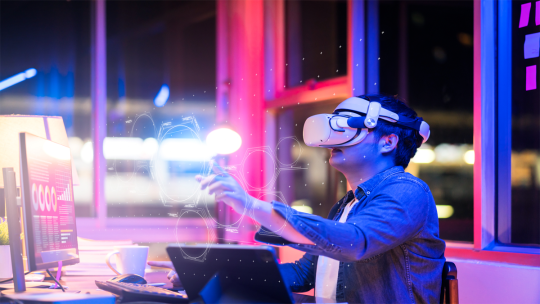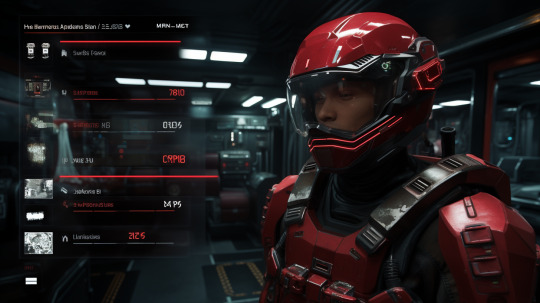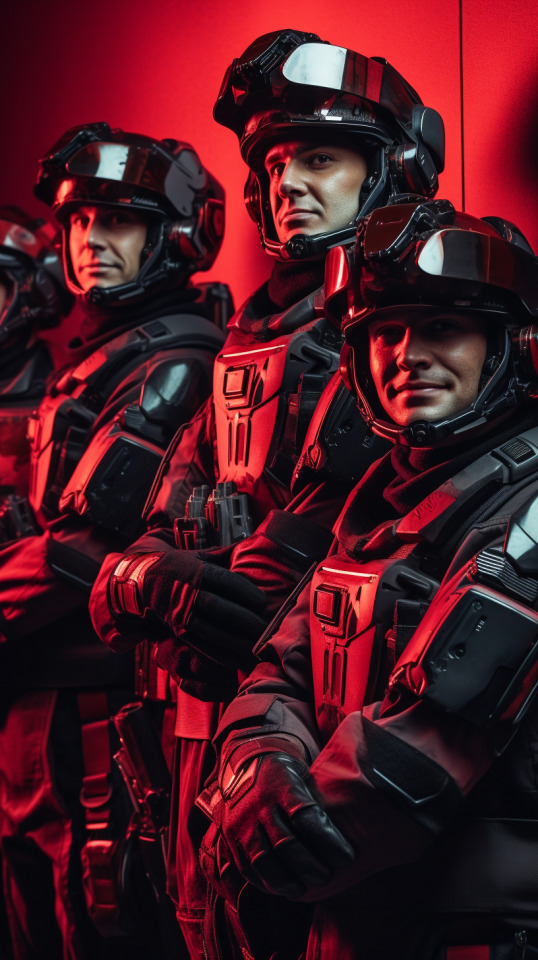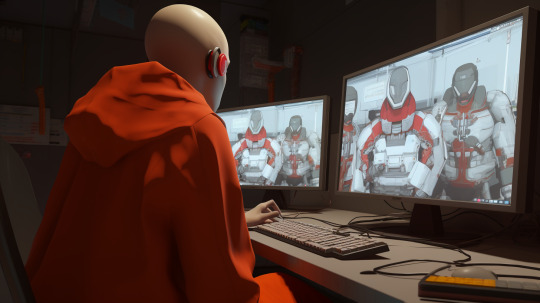#Virtual Reality Emergency Training
Explore tagged Tumblr posts
Text
In today’s rapidly evolving technological landscape, Metaverse technology is ushering in new dimensions for industries worldwide. As businesses adopt immersive digital environments for training, simulations, and customer experiences, one metaverse company in India is truly making its mark — Simulanis. This company specializes in creating cutting-edge metaverse development solutions and virtual reality (VR) simulators, transforming industries from fire safety to pharmaceutical training.
#Virtual Reality Safety Training#Immersive VR Simulators#VR Training for Firefighters#Metaverse Training Solutions#Virtual Reality Fire Training#Industrial VR Simulators#VR Training for Paint Spraying#VR Fire Extinguisher Simulator#Virtual Reality Emergency Training#VR-based Skill Training#Metaverse for Workforce Development#3D VR Simulators#Fire Safety VR Training Programs#Virtual Reality for Hazardous Training#Immersive VR Training for Manufacturing#Augmented Reality Productivity Tools#Metaverse Learning Experiences#Virtual Fire Safety Training India#VR Training for Healthcare#Simulation Training in Metaverse#Realistic VR Fire Training Simulators#Advanced VR Training Solutions#Virtual Reality Training for Engineers#Industrial Fire Extinguisher Simulator#Pharmaceutical VR Training Simulators#VR Training for High-Risk Jobs#Fire Safety Simulation Tools#Remote Assistance in VR Training#Metaverse Development for Enterprises#Immersive VR Training for Safety Procedures
0 notes
Text
Immersive Technologies in Business Transformation: How AR, VR, and MR Revolutionize Industries

In today's digital-first world, immersive technologies in business transformation are not just a trend—they're a necessity. Innovations such as Virtual Reality (VR), Augmented Reality (AR), and Mixed Reality (MR) are reshaping industries by enhancing operations, streamlining workflows, and driving growth. This article explores how businesses leverage these technologies to achieve transformative results.
Understanding Immersive Technologies
Immersive technologies blend the physical and virtual worlds, creating interactive environments. The main types include:
Virtual Reality (VR): Fully simulated environments for training, design, and entertainment.
Augmented Reality (AR): Digital overlays on the real world, enhancing user interaction.
Mixed Reality (MR): Integration of real and virtual elements for dynamic interactivity.
Extended Reality (XR): An umbrella term for AR, VR, and MR.
These technologies drive business transformation by offering innovative solutions to complex problems.
Applications of Immersive Technologies in Business
1. Revolutionizing Customer Experiences
Retail: AR-powered apps allow customers to "try before they buy," increasing sales conversions.
Real Estate: Virtual walkthroughs save time and deliver immersive property tours.
Hospitality: Hotels use VR tours to attract guests and showcase unique experiences.
2. Transforming Employee Training
VR Training Modules: Employees in industries like healthcare and manufacturing practice complex procedures in risk-free, realistic simulations.
AR Task Assistance: AR overlays guide employees in real-time, reducing errors and boosting productivity.
3. Boosting Collaboration
Virtual Meeting Rooms: Teams from across the globe collaborate in shared VR spaces, replicating the feel of in-person meetings.
Holographic Communication: Holograms bring a human touch to remote work, increasing engagement and understanding.
4. Streamlining Product Design and Prototyping
3D Visualization: Engineers and designers test prototypes in VR before manufacturing, saving costs and resources.
Iterative Improvements: Immersive tools accelerate the design process by facilitating real-time feedback.
5. Enhancing Marketing Strategies
AR Campaigns: Interactive ads using AR captivate audiences and elevate brand recall.
VR Showcases: Virtual reality offers an immersive way to experience products or services, making campaigns unforgettable.
Industries Transforming with Immersive Technologies
1. Healthcare
VR Therapy: Treat mental health issues like anxiety and PTSD with immersive simulations.
AR in Surgery: Surgeons use AR to visualize internal structures with precision.
2. Manufacturing
Digital Twins: Real-time virtual replicas of equipment enhance monitoring and predictive maintenance.
Safety Training: VR prepares workers for hazardous tasks in a safe, controlled environment.
3. Education
Immersive Learning: AR/VR creates engaging simulations, improving comprehension and retention.
4. Entertainment
From gaming to interactive movies, immersive technologies offer unique user experiences that captivate audiences.
Advantages of Immersive Technologies in Business Transformation
Improved Productivity: Real-time collaboration and automation reduce bottlenecks.
Enhanced Customer Engagement: Immersive experiences boost loyalty and satisfaction.
Cost Efficiency: Virtual environments eliminate the need for expensive physical setups.
Global Scalability: These tools facilitate seamless operations across borders.
Faster Decision-Making: Interactive visualizations provide better insights for informed choices.
Challenges in Adopting Immersive Technologies
High Implementation Costs
While initial costs can be significant, businesses can opt for scalable solutions to minimize investment risks.
Technical Barriers
Organizations need skilled professionals to maximize the benefits of these technologies. Upskilling programs and partnerships with experts can overcome this challenge.
Data Security Concerns
As immersive technologies collect vast amounts of data, ensuring compliance with privacy regulations and adopting robust cybersecurity measures is crucial.
Future Trends in Immersive Technologies for Business
The future of immersive technologies in business transformation looks promising:
AI-Driven Immersion: Artificial intelligence will create more personalized, intuitive immersive experiences.
Wider 5G Adoption: Faster networks will enable smoother, real-time AR/VR interactions.
Virtual Commerce (V-Commerce): Immersive shopping experiences will redefine e-commerce.
Cross-Industry Collaboration: Sectors like healthcare, education, and entertainment will integrate immersive tools for holistic solutions.
Businesses that adopt these technologies early will be better positioned to adapt to future market demands.
Conclusion
Immersive technologies are the cornerstone of business transformation. From enhancing customer engagement to optimizing operations, they open up a world of possibilities. By embracing AR, VR, and MR, businesses can innovate, scale, and lead in their industries. As these technologies evolve, their role in shaping a connected, immersive business landscape will only grow. The time to invest in immersive technologies is now—don’t just witness the future, be a part of it.
#Immersive Technologies#Immersive Technologies in Business Transformation#Mixed Reality Applications#Extended Reality Trends#Immersive Tech in Marketing#Virtual Reality Collaboration#Augmented Reality Training#Future of Business Technology#Immersive Tools for Enterprises#AR VR MR in Business#Emerging Technologies in Business#tagbin#technology#writers on tumblr#artificial intelligence#tagbin boardroomai
1 note
·
View note
Text
The Metaverse: A New Frontier in Digital Interaction

The concept of the metaverse has captivated the imagination of technologists, futurists, and businesses alike. Envisioned as a collective virtual shared space, the metaverse merges physical and digital realities, offering immersive experiences and unprecedented opportunities for interaction, commerce, and creativity. This article delves into the metaverse, its potential impact on various sectors, the technologies driving its development, and notable projects shaping this emerging landscape.
What is the Metaverse?
The metaverse is a digital universe that encompasses virtual and augmented reality, providing a persistent, shared, and interactive online environment. In the metaverse, users can create avatars, interact with others, attend virtual events, own virtual property, and engage in economic activities. Unlike traditional online experiences, the metaverse aims to replicate and enhance the real world, offering seamless integration of the physical and digital realms.
Key Components of the Metaverse
Virtual Worlds: Virtual worlds are digital environments where users can explore, interact, and create. Platforms like Decentraland, Sandbox, and VRChat offer expansive virtual spaces where users can build, socialize, and participate in various activities.
Augmented Reality (AR): AR overlays digital information onto the real world, enhancing user experiences through devices like smartphones and AR glasses. Examples include Pokémon GO and AR navigation apps that blend digital content with physical surroundings.
Virtual Reality (VR): VR provides immersive experiences through headsets that transport users to fully digital environments. Companies like Oculus, HTC Vive, and Sony PlayStation VR are leading the way in developing advanced VR hardware and software.
Blockchain Technology: Blockchain plays a crucial role in the metaverse by enabling decentralized ownership, digital scarcity, and secure transactions. NFTs (Non-Fungible Tokens) and cryptocurrencies are integral to the metaverse economy, allowing users to buy, sell, and trade virtual assets.
Digital Economy: The metaverse features a robust digital economy where users can earn, spend, and invest in virtual goods and services. Virtual real estate, digital art, and in-game items are examples of assets that hold real-world value within the metaverse.
Potential Impact of the Metaverse
Social Interaction: The metaverse offers new ways for people to connect and interact, transcending geographical boundaries. Virtual events, social spaces, and collaborative environments provide opportunities for meaningful engagement and community building.
Entertainment and Gaming: The entertainment and gaming industries are poised to benefit significantly from the metaverse. Immersive games, virtual concerts, and interactive storytelling experiences offer new dimensions of engagement and creativity.
Education and Training: The metaverse has the potential to revolutionize education and training by providing immersive, interactive learning environments. Virtual classrooms, simulations, and collaborative projects can enhance educational outcomes and accessibility.
Commerce and Retail: Virtual shopping experiences and digital marketplaces enable businesses to reach global audiences in innovative ways. Brands can create virtual storefronts, offer unique digital products, and engage customers through immersive experiences.
Work and Collaboration: The metaverse can transform the future of work by providing virtual offices, meeting spaces, and collaborative tools. Remote work and global collaboration become more seamless and engaging in a fully digital environment.
Technologies Driving the Metaverse
5G Connectivity: High-speed, low-latency 5G networks are essential for delivering seamless and responsive metaverse experiences. Enhanced connectivity enables real-time interactions and high-quality streaming of immersive content.
Advanced Graphics and Computing: Powerful graphics processing units (GPUs) and cloud computing resources are crucial for rendering detailed virtual environments and supporting large-scale metaverse platforms.
Artificial Intelligence (AI): AI enhances the metaverse by enabling realistic avatars, intelligent virtual assistants, and dynamic content generation. AI-driven algorithms can personalize experiences and optimize virtual interactions.
Wearable Technology: Wearable devices, such as VR headsets, AR glasses, and haptic feedback suits, provide users with immersive and interactive experiences. Advancements in wearable technology are critical for enhancing the metaverse experience.
Notable Metaverse Projects
Decentraland: Decentraland is a decentralized virtual world where users can buy, sell, and develop virtual real estate as NFTs. The platform offers a wide range of experiences, from gaming and socializing to virtual commerce and education.
Sandbox: Sandbox is a virtual world that allows users to create, own, and monetize their gaming experiences using blockchain technology. The platform's user-generated content and virtual real estate model have attracted a vibrant community of creators and players.
Facebook's Meta: Facebook's rebranding to Meta underscores its commitment to building the metaverse. Meta aims to create interconnected virtual spaces for social interaction, work, and entertainment, leveraging its existing social media infrastructure.
Roblox: Roblox is an online platform that enables users to create and play games developed by other users. With its extensive user-generated content and virtual economy, Roblox exemplifies the potential of the metaverse in gaming and social interaction.
Sexy Meme Coin (SEXXXY): Sexy Meme Coin integrates metaverse elements by offering a decentralized marketplace for buying, selling, and trading memes as NFTs. This unique approach combines humor, creativity, and digital ownership, adding a distinct flavor to the metaverse landscape. Learn more about Sexy Meme Coin at Sexy Meme Coin.
The Future of the Metaverse
The metaverse is still in its early stages, but its potential to reshape digital interaction is immense. As technology advances and more industries explore its possibilities, the metaverse is likely to become an integral part of our daily lives. Collaboration between technology providers, content creators, and businesses will drive the development of the metaverse, creating new opportunities for innovation and growth.
Conclusion
The metaverse represents a new frontier in digital interaction, offering immersive and interconnected experiences that bridge the physical and digital worlds. With its potential to transform social interaction, entertainment, education, commerce, and work, the metaverse is poised to revolutionize various aspects of our lives. Notable projects like Decentraland, Sandbox, Meta, Roblox, and Sexy Meme Coin are at the forefront of this transformation, showcasing the diverse possibilities within this emerging digital universe.
For those interested in the playful and innovative side of the metaverse, Sexy Meme Coin offers a unique and entertaining platform. Visit Sexy Meme Coin to explore this exciting project and join the community.
272 notes
·
View notes
Text
002 | Richmond Inc.



「 ✦ full library & archive ✦ 」
「 ✦ aaron pierre & characters library ✦ 」
⇚ 001
♠ authors note: hi! wow, wow, wow - the first part of this is doing so well. thanks to everyone who has liked, commented and reblogged. a few notes firstly- I've changed the POV . Our OC is Lorence Cole commonly referred to as Cole professionally, no worries though she’s very much a black woman.
♠ summary: Terry Richmond is still keen on recruiting Lorence for the open directors position within his security firm. Her stellar results during both tactical and physical trials makes her a top candidate but his reputation is in the way of her eager acceptance of the offer.
♠ pairing: Terry Richmond (Aaron Pierre - Rebel Ridge) X Lorence Cole (Black Fem OC)
♠ word-count: ~1.5K

⌖ - Richmond Inc. Training HQ
Second to being in the presence of the Boss, tactical day is my second least favourite part of my job. It’s not that I’m a pacifist but the idea of pulling the trigger and striking a human being in a vital artery is the last thing I want to be doing. Securing my ear protection I let the rounds go being as precise as possible so I can leave sooner than later. This training is proactive and preventative for agents like me who never see the more violent side of the field. It's a necessary evil. A team is only as strong as their weakest link and if shit ever hits the fan I never want to be the person left behind who can't carry their own weight.
“Hey Cole join our competition” a couple of the guys call as I pack up the firearm.
“No thanks” I respond. “Wouldn’t want to make you boys look bad.” I add playfully and they all laugh telling me my comment is wishful thinking. The Boss is huge on being proactive. Since its inception Richmond Inc. has only lost one employee while on assignment. That was while he was being a hero and not doing what we were trained to do. I move onto a larger weapon and look through the scope taking the stationary targets down one by one before heading on to the moving targets course. This one is a simulation, kind of like virtual reality but it feels real. It’s a culmination of all of our training, unfortunately us women are required to perform it twice. Once with heels and the other time in footwear of our choosing. My score is satisfactory and I relax after finishing the tactical portion. I take a short breather before I head to finish the physical training. Some of the field agents come out to place the weighted vests and ankle weights on me before I’m forced into the pool. Stay afloat for twenty minutes or cross the length of the pool twice. I manage the crossing with difficulty before I’m pulled up from the up edge. It’s the track that sees me next. I dry off as much as I can before making quick work of the three miles within the time constraints. When I’m finished I take my time in the sauna before changing. I get dressed and make myself presentable before emerging from the facilities. I’m gonna need an energy drink and a coffee to make it through the rest of today. Chatter gets my attention and I find the Boss standing in front of the exit. I look for another exit to avoid any interactions. I curse myself again for finishing so quickly - I wouldn't have if I knew he was in town.
“Lorence, of course you’re top twenty” A familiar voice shouts, blowing my attempt at discretion. Still, I smile at the sight of my mentor wearing a proud smile. Joel taught me everything I know about passing both the tactical and physical trials, lord knows I was bottom ten when I first joined the firm. “Rich told me you declined a director position. Why would you do that? You have everything it takes.” He asks discreetly. Unlike the Boss Joel is generous, kind and patient. He spoiled me with his easy going temperament. If it were a director position under him there’d be nothing to discuss. I’d sign the dotted line in a heartbeat. The possibilities of how ugly this job can become would be my only worry and not verbal abuse from time to time.
“I’m not good under pressure” I mutter.
“Yeah fucking right. How many times have you talked us out of a bind?” Joel asks like a proud father figure. His greatest leadership quality is that he likes to see others shine and knows how to get the light out of them. “More than half of us in the field aren’t as smart as you. Negotiate. The Boss isn’t above reason and always puts the company first. I can put in a good word.” Joel offers.
“It’s not that I’m smarter, it's that none of you guys listen. I’m not interested in Joel” I respond jokingly.
“No, your testing proves you’re the right one for the position” he says.
I sigh. “I enjoy my life, okay?”
“What, sitting on an overpriced couch? Spending hours cooking for one?” Joel teases and I glare at him while he has a laugh at my expense.
“Come on, try the winter circuit - it’s lowkey and easy to get your feet wet. You can shadow me. $750k to do what you can do in your sleep” Joel says being a salesman.
“What? Do you get a commission?” I tease.
“No, I'll get my best agent back.” Joel says.
I take a deep breath in and weigh my options. “I have one condition before I seriously consider it. If you don’t think it’s possible then drop it”
“What” Joel asks, brow raised and ready for a challenge.
“I deal with you and not the Boss” I tell Joel who seizes up. His brows bunch like it's the most ridiculous request. Confusion covers his expression, most of why people become directors is for the position's proximity to Mr. Richmond. It's worth his weight in gold. “You know I make mistakes in the beginning and he’s an eagle eyed freak who blows up on people. I don’t do well with that. If you can take the tirades for me I’ll consider the promotion” I explain and understanding settles into his expression. He nods looking down dimples settling into his cheeks.
“You’ve gotta be fucking kidding me.” Joel laughs shaking his head side to side.
I’m not at all amused. “It’s my line, it’s my condition. I like peace”
“Are you being this insane for praise too or just criticism?” Joel asks, patronizing me.
“Both are fine with me, they can trickle down through you” I shrug and the hulk himself comes over looking down at his tablet. Black cashmere sweater, silver watch, grey cargos and a fresh trim. Stop it, I scorn my thoughts as he joins us.
“Impressive results Cole” Richmond says.
“Thank you, Joel taught me everything I know” I confess and Joel gives me a half smile.
“She’s a quick study” Joel says, throwing a compliment back my way.
Richmond continues scrolling on the tablet before pausing. He looks up with visible concern. “Monitors show significant distress while shooting.”
“Pacifist” Joel smiles looking from me to the Boss. “Unless bugs are involved. No bodies, no blood” Joel explains.
“Hmm” Richmond says, tapping on the tablet.
“You’re virtually fearless though” he says, continuing to scroll like I'm not right in front of him.
“Exactly. An unreasonable amount of disregard for her own well being but tremendous concern for others. It’s what makes her one of one” Joel says, being exactly the kind of sponsor I’d want under any other circumstance.
“I see,” the Boss nods, looking at me. I hold his gaze for a few seconds before turning back to Joel.
“Well Joel I hope you know you’re getting nothing for that flattery. I’m heading home. Mr. Richmond” I interject nodding in the Boss’ direction to cut the conversation short. It’s like a part of me knows observing Richmond from afar is fine but up close it’s hard to forget I'm in the presence of someone absolutely lethal.
“Drive safe” Joel responds and I nod.
“You too, thanks” I force a smile heading out the front door and into my car where I take a few deep breaths. When I pull out of the lot I see Joel and Richmond in conversation and cringe internally. The agent in me says suck it up and take the position but every other part is warning bells that say stay away. Just the thought of one of his full metal jacket tirades makes me shudder in place. Maybe that’s what was required of him in the army but it doesn't inspire people like me who want to do good. I don’t need anyone telling me what an idiot I am after I make a mistake I know better than anyone else. I was sick for a week when one of my proposed exit routes was subject to a traffic jam. I was the head logistics navigator and spent the next thirty minutes covering my ass to save the clients. Although everything went off without a hitch I demoted myself. Joel was generous but no amount of consolation minimized the fact that I shit the bed. I ran another 10 assignments at a subordinate rank before I felt comfortable at head rank again. The margin of error for director’s is less forgiving under certain circumstances. Gaining intel and filtering for what's necessary is no small feat the success of every project is on your shoulders and so are everyone else’s fuck ups.
New directors are routinely on the Bosses bad side and that's a place I never want to be.
003 ⇛

authors note: thanks for reading 🖤 sound off in the comments on if you think Lorence is making good or bad decisions in regards to her promotion and how we think Mr. Richmond handles her terms 💭 cant wait to see what you all think!
don't forget to ❣ Like, ❝ Comment, ↺ Reblog ☑vote on the polls taglist deets & FAQ's here - ✮ join taglist ✮
tags:
@meadows5 @wnbweasley @becauseimher @ariiaeltheedonn @woahthatshitfat @miniaturehideoutmentality @kokobells @ffenthusiastt @sowhatariyana @1xtral1983 @theegoddessofmelanin @fictionalreads @roxytheimmortal @fairytale07 @rampsen @rosey1981 @lauraaan182 @lynaye1993 @g1g1l @writingsbytee @different-fandomz @rose-bliss @loveschrisbrown20 @cherrybeedotcom @ariiaellbtheedonn
#aaron pierre fanfic#aaron pierre imagine#aaron pierre#aaron pierre x black reader#aaron pierre x black!oc#aaron pierre x oc#terry richmond imagine#terry richmond#rebel ridge fanfiction#rebel ridge#terry#terry richmond x black reader#terry richmond x black oc
175 notes
·
View notes
Text
Connecting our dream worlds to our conscious realities might be entirely possible, according to emerging research. A new study by three researchers from the US neurotechnology company, REMspace, has shown with a bit of training, some of us might be able to react and respond to devices around us while we are 'lucidly' dreaming. Lucid dreaming is the ability to recognize you are in a dream while you are in it. It's a trainable skill, although about half the population has experienced the phenomenon spontaneously.
Continue Reading.
123 notes
·
View notes
Text
Training afternoon
The recruits listened as 6DG05's voice resonated within their helmets, a digital symphony of authority and guidance. The field lay before them, a vast expanse of simulated and real challenges, something not easy to keep apart inside the helmets that totally controlled their sensory input.

6DG05's voice resonated through the recruits' helmets, cutting through the digital landscape like a calculated breeze. His explanation wove through the intricacies of the Corps' methodology, emphasizing the seemingly paradoxical benefits of controlled sensory input.
"Recruits," he began, his tone carrying a subtle mixture of authority and explanation, "the controlled sensory input is not just a feature; it's a crucial aspect of your training. In this controlled environment, we can fine-tune your experiences, exposing you to a spectrum of challenges that transcend the limitations of traditional training methods."
He elaborated on the advantages, dissecting the nuances of their immersive training. "By manipulating your sensory perception, we can simulate a vast array of scenarios – from chaotic battlefield emergencies to nuanced medical procedures.
Inside the confines of their helmets, IU664 and H2U8M found a rare moment to converse, their voices digitalized and encrypted, resonating within the sealed space.

IU664's voice, slightly distorted by the helmet's communication system, cut through the virtual landscape. "It's disturbing, isn't it? Not knowing where the line between reality and simulation is drawn."
H2U8M, navigating the simulated challenges alongside IU664, responded, "Yeah, it messes with your head. Everything feels real, but then again, it might not be."
The digital symphony of their voices interwove with the simulated sounds of the field, creating a surreal backdrop to their conversation.
"I mean, how do we know if what we're experiencing is genuine or just another layer of the Corps' conditioning?" IU664 pondered.
"Uncertainty breeds adaptability. It's part of their method. Keep us guessing, keep us sharp."
The urgent call from T4C7L pierced through the recruits' simulated environment, pulling them from the complexities of their virtual challenges. Racing toward the coordinates, IU664 and H2U8M, found themselves face to face with a disturbing scene.
The field kitchen, where they just had eaten lay in ruins. Smoke billowed from the wreckage, and the harsh glow of flames cast eerie shadows on the digital landscape. As they approached T4C7L's prone figure, a sense of urgency permeated the simulation.
Lifting debris with their gauntleted hands, IU664 and H2U8M uncovered the injured T4C7L. His moans resonated in their helmets, creating an unsettling juxtaposition with the chaos of the disaster.
T4C7L lay there, his left leg severed by a cruel piece of virtual debris. The recruits, not knowing if this was real or part of the simulation's artificial nature, felt a surge of empathy and concern for their fallen comrade.

"Stay with me, T4C7L," IU664 urged, his digital voice carrying a hint of urgency.
H2U8M, assessing the injury, stated, "We need to stabilize him. The AI should guide us through the procedure."
As they engaged in the simulated medical emergency, the line between reality and virtuality blurred. The immersive nature of the training demanded their full attention, compelling them to respond to the simulated crisis with a blend of tactical skill and compassionate care. In the Corps, even the most controlled environments carried the weight of uncertainty and the imperative to act.
Following the AI's guidance, H2U8M took charge of the situation, his gauntleted hands working with precision to address the virtual trauma. The HUD within his helmet displayed step-by-step instructions, an ethereal guide in the midst of the simulated crisis.
IU664, his attention focused on the task at hand, assisted by providing tools and materials as prompted by the AI. Together, they worked to staunch the bleeding, following the carefully choreographed motions dictated by the digital guide.

The HUD displayed vital signs and diagnostics related to T4C7L's condition. The integrated medi-kit had administered pain medication to alleviate T4C7L's suffering, and the virtual readouts indicated a stabilization of his vital signs.
H2U8M and IU664, still in the midst of the emergency, assessed the data provided by the suit. The digital interface guided them through the next steps, prompting them to check for any other injuries and ensure that T4C7L remained stable until further assistance arrived.
The surreal blend of the real and the simulated created a unique atmosphere within the paramedic suits. The recruits, immersed in the scenario, relied on the seamless integration of technology and training to navigate the challenges presented to them.
Mission Control's voice resonated in their helmets, instructing them to evacuate T4C7L to a designated safe zone approximately 2 km away. The recruits, relying on the suit's enhanced strength and the knowledge gained through their training, carefully lifted and secured T4C7L onto a makeshift stretcher.

The HUD provided a digital map overlay, guiding them through the simulated terrain. The recruits, now fully immersed in the scenario, navigated the challenges of the field with precision. The weight of their injured comrade served as a constant reminder of the gravity of their mission.
As they moved toward the designated safe zone, the AI continued to offer guidance and feedback, assessing their actions and responses.
H2U8M's voice resonated through the secure channel, the digital encryption ensuring their conversation remained private within the confines of their helmets.

H2U8M: "This feels real, doesn't it? The weight of T4C7L, the urgency of the mission. It's all too convincing."
IU664: "I agree. The details, the sensory input—simulations don't usually feel this tangible. But then again, we're dealing with a level of technology that blurs the lines between reality and simulation."
H2U8M: "What if they're testing us, pushing us to question the nature of the scenario? It's all part of their conditioning methods."
T4C7L's voice crackled through their secure communication channel, his tone a mix of pain and frustration.
T4C7L: "You stupid cucumbers, this is as real as it gets. The pain in my leg is real, the wreckage around me is real. Now, less talking, more moving. Get me out of here."
H2U8M and IU664, though relieved to have some confirmation of the reality of the situation, focused on the task at hand.
The AI-induced partial failures added an extra layer of challenge for the recruits. H2U8M and IU664, tasked with carrying the simulated injured T4C7L, found their suits responding sluggishly, resistors intermittently activating, and the feedback loops creating unpredictable resistance.
As they struggled with the simulated technical issues, the instructors watched the recruits' responses closely through the telemetry data. The suits' HUDs flickered, displaying false alarms and misleading information, testing the recruits' ability to troubleshoot and adapt.
Amidst the simulated chaos, H2U8M and IU664 lifted the incapacitated T4C7L, the weight feeling unexpectedly variable due to the simulated suit malfunctions.
Inside the encrypted communication channel, IU664's voice crackled into H2U8M's helmet, laden with a mix of frustration and amusement.

As 6DG05 observed the recruits' progress, a mischievous thought crossed his mind. With a subtle command to the AI, he decided to add an extra layer of challenge.
6DG05: "Let's keep them on their toes. AI, introduce some glitches into their suits, nothing too extreme, just enough to test their adaptability and problem-solving skills."
The HUDs of the recruits flickered momentarily, introducing simulated glitches that distorted visuals and generated sporadic sensor errors. The recruits, unaware of the deliberate interference, now faced an additional layer of complexity in the already challenging simulation.
IU664: "Did you feel that glitch, H2U8M? Something's off, and I don't think it's just part of the simulation."
6DG05 observed the recruits' actions on the HUD telemetry feed. Satisfied with IU664 and H2U8M's performance in stabilizing and evacuating T4C7L, he allowed a sense of approval to creep into his thoughts.
H2U8M: "Yeah, I noticed. Feels like the suits are playing tricks on us. Maybe they've upgraded the training scenarios, or it's another layer of conditioning."

T4C7L, lying on the simulated ground, spoke through the helmet's speakers, his voice carrying a mix of urgency and simulated pain.
T4C7L: "Come on, recruits! This isn't a stroll in the park. I need help. Get me to that ambulance, and make it quick. No time to dilly-dally."
Amidst the simulated chaos and controlled disarray of the training exercise, IU664 and H2U8M rushed towards the waiting Instructor KO10T, their minds instantly reverting to the systematic approach they'd been trained to follow in such situations.
IU664, his voice calm and focused despite the surrounding turmoil, relayed the critical information. "Instructor, we've encountered a casualty. Assessing his condition using the ABCDE approach: Airway's clear, breathing labored, pulse is thready, conscious but showing signs of distress. Extremity injury to the left leg, traumatic amputation. Bleeding is controlled."
H2U8M, maintaining composure, joined in. "Checking his Disability and Exposure—conscious and oriented, no other evident injuries. Estimated blood loss is moderate but manageable. Requesting immediate evac, sir."
Instructor KO10T, taking in the urgency in their voices, nodded in acknowledgment. "Understood. Prepping for immediate evacuation. Excellent work, both of you. Let's get him to safety."
The visors ascended with a faint hiss, revealing the training ground in all its controlled normalcy. The chaotic scenes of a simulated emergency melted away, leaving IU664 and H2U8M blinking in the calibrated lighting of the training area.
The instructors, KO10T and 6DG05, observed with a discerning eye, assessing the recruits' reactions to the simulation's conclusion.
The training ground, once a staged battlefield of urgency and simulated injuries, now revealed T4C7L standing before them, seemingly whole except for the absent leg that remained in the simulation.
T4C7L, having played his role in the training exercise, maintained a composed demeanor despite the apparent incongruity of his missing leg.

T4C7L, noticing their confusion, spoke up. "Ah, the leg. I guess I forgot to mention it during the briefing. Lost it in a motorcycle accident when I was seventeen. But they fixed me up real good, got me back on my feet, or foot, so to speak. Decided I wanted to serve, to be on the other side, helping folks just like the guys who helped me."
T4C7L, noting the lingering surprise on the faces of IU664 and H2U8M, grinned. "Don't worry, mates. I'm not as handicapped as it might seem. The leg I lost years ago has been replaced by this marvel of technology." He tapped on the sleek surface of his suit's leg, revealing the hidden, fully functional prosthetic limb.
The recruits, still processing the revelations, marveled at the seamless integration of advanced prosthetics into the tactical paramedic suits. It was a testament to the level of technology they were immersed in, where disabilities could be overcome with cutting-edge innovations.
T4C7L continued, "This prosthetic is more than just a replacement. It's an enhancement, a piece of gear that complements the suit and makes me as effective as any of you." He flexed the prosthetic, demonstrating its range of motion and adaptability.
The revelation about T4C7L's prosthetic leg added another layer of complexity to IU664 and H2U8M's understanding of their immersive training. The blurring line between simulation and reality became increasingly elusive, and the recruits found themselves questioning the authenticity of their experiences.
The instructors, masters of this carefully constructed reality, watched silently, knowing that each twist in the training narrative served a purpose beyond the recruits' immediate comprehension.
KO10T, realizing the disconcerting nature of the training, approached IU664 and H2U8M. His inquiry about their needs and the offer to adjust the environment for their comfort revealed a subtle acknowledgment of the psychological strain the immersive scenarios imposed on the recruits.
With a controlled, yet understanding tone, KO10T conveyed, "Do you need anything, recruits? Take a moment. I'll give you control over the suits. You can decide whether to keep the visors open or closed, whatever makes you more comfortable."

The choice offered a semblance of autonomy within the structured training environment. As the visors lifted, the recruits found themselves facing the training ground once again, now free from the immersive overlays that dictated their experiences. The ambient sounds of the training site became more pronounced, grounding them in the tangible reality of their surroundings.
U664 and H2U8M, visors open to the training ground's unfiltered reality, sipped their hot tea as they joined KO10T and T4C7L in preparing for the next team's immersive scenario. The banter flowed naturally between the recruits and their instructors, a brief interlude of camaraderie amid the intense training regimen.
KO10T, while overseeing the setup, engaged in light banter with the recruits. "Well, recruits, how did it feel to face the unexpected? This training isn't your typical walk in the park, but you handled it well."
H2U8M chuckled, "I have to admit, I wasn't sure if we were dealing with a simulation or a real emergency back there. You've got us on our toes, Instructor."
T4C7L, adjusting some equipment nearby, added, "Ah, the blend of reality and simulation, keeps you sharp, doesn't it? It's what makes our paramedics the best in the field."

T4C7L asks H2U8M to carry him in the Fireman's carry to the simulated explosion site
H2U8M, responding to T4C7L's request with a smirk, said, "Sure thing, T4C7L. Ready for a scenic tour of our simulated chaos?" He crouched down, allowing T4C7L to climb onto his back in a fireman's carry.
As H2U8M walked toward the designated area, T4C7L playfully remarked, "Ah, the perks of having recruits who can lift you like a feather."
"Consider it part of our paramedic fitness training, sir," H2U8M quipped, maintaining the camaraderie amid the unconventional scenario.
H2U8M carefully lowered T4C7L to the ground, and T4C7L continued to play his part in setting the stage. He pointed to a small container labeled "artificial blood" nearby and instructed, "There you go, H2U8M. Make it look dramatic. We want the next team to think they're in for a real challenge."
H2U8M, with a hint of a smile beneath his helmet, picked up the container and applied the artificial blood to the prosthetic stump, creating a convincing illusion of injury. T4C7L, lying on the ground, maintained a serious expression, adding to the realism of the scene.
KO10T, overseeing the preparations, nodded in approval. "Good job, recruits. This will set the tone for the next team. Remember, realism is key in our training."
KO10T told the recruits: "If you want you watch your mates go through the same scenario as you did, but you will have to lower the visors."

U664 glanced at H2U8M, and they exchanged a silent agreement. With a synchronized motion, they lowered their visors, immersing themselves back into the controlled environment of the suits. The training ground transformed once again, the HUD overlaying data and simulations on their vision.
KO10T's voice echoed in their helmets, "Welcome to the observer's perspective, recruits. Take a moment to see how your fellow paramedics handle the challenges. It's a valuable part of your training."
As they watched their comrades navigating the simulated emergencies, H2U8M couldn't help but feel a mix of curiosity and camaraderie. IU664, sharing the sentiment, remarked over their encrypted channel, "It's strange being on this side, isn't it? Almost like watching a performance, but with a deeper understanding."
"Yeah," replied H2U8M, "you get a different appreciation for the complexities of the scenarios when you're not in the thick of it. Let's see how they tackle it."
Finally the last team of their platoon emerged. Most of them were as stunned as H2U8M from the final scenario.
As the last team completed the scenario, the recruits gathered, their visors lifted to reveal a mix of sweat-soaked and bewildered faces. The training ground, once a battleground of simulations and challenges, now required their attention for cleanup.
KO10T's voice cut through their helmets, "Good work, recruits. Visors up for now. Take a moment to catch your breath. We'll march back to the barracks once the site is cleaned up."
IU664 and H2U8M joined the rest of the platoon in the post-scenario haze. The disorientation lingered as they helped tidy the training area. Equipment was stowed, and remnants of the simulated emergencies were cleared away.

H2U8M retrieved T4C7L's prosthetic leg and handed it to him. T4C7L deftly attached the prosthetic, securing it in place with practiced ease. As the mechanical components engaged, the leg seemed to seamlessly integrate with his suit.
T4C7L stood up, testing the prosthetic limb. The movement was fluid, a testament to the advanced technology that augmented his abilities. The recruits, still gathered and cleaning up the training site, watched with a mixture of curiosity and admiration.
IU664, intrigued by the seamless integration of the prosthetic with the suit, couldn't help but ask over their helmet communication, "How does it feel, T4C7L? Having a leg like that?"
T4C7L, now standing steadily, replied with a grin audible in his voice, "Feels like I never lost it in the first place. The tech these suits have is something else. Now, let's finish up here and head back. Good job today, everyone."
The platoon marched in unison, their visors down, the rhythmic thud of boots echoing through the simulated night. The HUDs provided a subtle green glow, enhancing their vision in the darkness. The recruits moved with a disciplined precision, the day's immersive training still fresh in their minds.
IU664 and H2U8M, side by side in the formation, exchanged a few words over their helmet communication. The day's events had left an indelible mark on their perception of the training, blurring the lines between simulation and reality.

H2U8M remarked, "Never thought I'd see someone attach a prosthetic leg to a suit like that."
IU664 replied, "Yeah, the technology is impressive. Makes you wonder what else these suits can do."
As they moved to the decontamination area, H2U8M turned to IU664, visor still lifted, "Quite a day, huh? I never expected this level of intensity when we started."
The recruits moved through the decontamination process, shedding the remnants of the scenarios they had faced. The barracks awaited them, a place where they could rest, reflect, and prepare for the next phase of their paramedic training.
The platoon filed into the barracks, the air hissing as the docking clamps engaged, securing the recruits in their suits.

Inside the barracks, the visors lifted, revealing a room filled with exhausted but focused faces. The instructors, including T4C7L, who had rejoined them, prepared to discuss the day's events and lessons learned. The recruits, visors now transparent, awaited the debriefing that would shed light on the complexities of their futuristic training.
The mechanical symphony of replenishment and recharging began, each suit connected to its designated station.
The suits, now in a passive state, initiated their self-maintenance routines. he HUDs displayed diagnostic data, ensuring that each suit received the necessary attention for the upcoming days of training.
IU664 glanced at H2U8M, their expressions hidden behind the helmets. "It's like we're part of some advanced, living organism," IU664 remarked, the fatigue of the day's training evident in his voice.
The classroom, now illuminated by the overhead lights, awaited the instructors' debriefing.
The recruits' HUDs illuminated with a cascading stream of data, an automated report detailing their performance throughout the day. Bright green indicators marked areas of success, while cautionary amber signals highlighted aspects needing improvement.
IU664's eyes scanned the detailed breakdown of his actions during the simulated emergency scenarios. The HUD displayed commendations for swift responses, accurate diagnostics, and effective communication with H2U8M. Yet, there were amber warnings, cautioning him about a slightly delayed reaction time during the evacuation phase.
H2U8M's HUD presented a similar array of information. The system praised his effective wound management and coordination with IU664, but a cautionary note suggested a need for more precision in administering certain medical procedures.

The recruits, still inside their suits, exchanged glances. The silent feedback from their AI-guided assessments brought a mix of satisfaction and determination. It was a constant loop of improvement — an intricate dance between human decision-making and the enhancements offered by the advanced technology woven into their suits.
IU664 tapped a few virtual buttons on his HUD, accessing a broader analysis of their overall platoon performance. The report extended beyond individual accomplishments, providing insights into the collective efficiency and potential areas for group synergy.
"It's like a digital debriefing," IU664 remarked, his voice reverberating within the confines of the helmet.
H2U8M nodded, "They've quantified every move, every decision. We're not just learning from our experiences; the system is optimizing us."
As the recruits absorbed the data and recommendations, the automated voice of the AI chimed in through their helmets, "Tomorrow is a new day of training. Optimize, adapt, overcome."
The instructors, their voices resonating through the recruits' helmets, issued the command: "Initiate docking procedures. It's time to rest."
The recruits, visors descending to create a cocoon of isolation, marched in unison toward the docking stations. The rhythmic hiss of docking clamps engaged, securing each recruit in place. The ambient hum of the suits' machinery became a lullaby, a mechanical symphony serenading them into a state of rest.

As the recruits settled into their individual stations, the suits initiated a sequence. The once active HUD now dimmed, transitioning into a soft, ambient glow. Inside the sealed helmets, the recruits experienced a gradual disconnection from the external world.
In the virtual space of their HUD, the instructors relayed a message: "Rest well, recruits. Tomorrow awaits new challenges."
The recruits' bodies reclined in the docking stations, embraced by the contours of their suits. The AI, ever vigilant, monitored their vital signs and sleep patterns. As the recruits drifted into the realm of dreams, the suits maintained a silent watch, ready to awaken them at the appointed hour.

20 notes
·
View notes
Text
AI Coaches to Biohacking: The Future of Fitness Unveiled
The international of health is constantly evolving, with new trends emerging every 12 months. In 2025, health fans are embracing contemporary era, personalized education, and holistic wellness methods. Whether you’re a gym-goer or decide on at-domestic workout routines, these tendencies will assist you stay beforehand to your health adventure.
Latest Fitness Trends For Women

1. Wearable Technology and Smart Fitness Gear
Wearable health trackers were around for some time, but 2025 has visible them emerge as even more superior. Smartwatches and fitness bands now provide actual-time health tracking, AI-pushed coaching, and progressed metrics including HRV (Heart Rate Variability), VO2 max, and strain level analysis.
Additionally, clever clothing embedded with sensors is gaining recognition, permitting customers to monitor form and muscle engagement. This innovation facilitates save you accidents and optimize exercises.
2. AI-Powered Personal Training
Artificial intelligence is revolutionizing personal schooling by presenting custom designed fitness plans tailored to individual wishes. AI-pushed apps analyze customers’ exercise history, nutrition behavior, and dreams to provide adaptive schooling workouts. Virtual non-public running shoes now provide real-time comments, ensuring right shape and exercising execution.
3. Hybrid Workouts: Online and In-Person
While on line fitness instructions surged throughout the pandemic, in-character schooling is making a robust comeback. Hybrid exercise fashions combine the first-rate of each worlds, permitting people to attend live instructions inside the health club while also collaborating in digital periods at home. This approach gives flexibility even as preserving a feel of community.
Four. Mind-Body Workouts and Mental Wellness Integration
More human beings are spotting the relationship among intellectual fitness and bodily fitness. Practices including yoga, Pilates, and breathwork are being incorporated into traditional workout workouts. Gyms and health apps at the moment are supplying meditation periods and stress-reducing sports along energy and cardio training.
5. High-Intensity Interval Training (HIIT) Evolution
HIIT remains a staple in fitness, but it has evolved to encompass new versions inclusive of hybrid HIIT, in which power schooling and cardiovascular exercises are seamlessly mixed. Additionally, micro-HIIT workout routines (5-10 minutes) cater to individuals with tight schedules, making sure they are able to still get effective results in much less time.
6. Gamification of Fitness
Fitness apps and platforms are leveraging gamification to keep users inspired. Virtual demanding situations, leaderboards, and reward-based systems encourage consistency and engagement. VR (Virtual Reality) health is also gaining traction, allowing users to immerse themselves in interactive exercise environments.
7. Sustainable and Eco-Friendly Fitness Practices
Sustainability is influencing the fitness enterprise, with eco-friendly gyms the usage of renewable energy and sustainable exercise equipment turning into mainstream. Brands are creating biodegradable yoga mats, recycled gymnasium apparel, and sustainable water bottles to decrease environmental impact.
Eight. Biohacking for Optimal Performance
Biohacking entails the usage of technology and era to beautify bodily overall performance and recuperation. This consists of cold plunges, pink mild therapy, and wearable restoration devices that optimize muscle repair. Nutritional biohacking, inclusive of personalised dietary supplements and DNA-based meal plans, is also at the upward push.
Nine. Functional Fitness and Longevity Training
Rather than focusing completely on aesthetics, human beings are prioritizing practical moves that improve mobility, stability, and longevity. Exercises consisting of kettlebell swings, body weight schooling, and mobility drills assist beautify ordinary movements, reduce injury dangers, and promote a longer, healthier life.
10. Social Fitness and Community-Driven Workouts
Group training, fitness challenges, and social media-pushed duty corporations are getting greater famous. Whether thru in-man or woman boot camps or on line exercise communities, human beings are leveraging the energy of social connection to stay stimulated and responsible of their fitness journey.
11. Recovery and Regeneration Focus
Recognizing the significance of recuperation, fitness lovers are investing in techniques inclusive of foam rolling, percussive remedy, and sleep optimization to decorate muscle recovery. Cryotherapy and infrared sauna periods are also being widely used for decreasing infection and speeding up recovery.
12. Personalized Nutrition and Gut Health Awareness
Nutrition is an crucial part of health, and in 2025, customized nutrients plans primarily based on intestine fitness evaluation are trending. Advances in microbiome research permit people to tailor their diets primarily based on their precise intestine micro organism, enhancing digestion, strength stages, and average health.
13. Adaptive and Inclusive Fitness
The fitness enterprise is turning into greater inclusive, with tailored applications for individuals with disabilities, seniors, and people with persistent situations. Adaptive system and virtual training platforms are making health accessible to each person, regardless of their bodily limitations.
14. Outdoor and Adventure-Based Workouts
Nature-based totally fitness is gaining reputation as people searching for to get away traditional health club settings. Activities which include trail walking, mountain climbing, and out of doors boot camps offer both physical and mental blessings. Organizations also are supplying fitness retreats that integrate exercising with journey travel.
15. Strength Training for All Ages and Genders
Strength training is now not seen as only for bodybuilders. More girls are embracing resistance training, and older adults are incorporating weightlifting into their exercises to prevent muscle loss and improve bone density. The stigma around lifting heavy is fading as human beings apprehend its long-time period advantages.
How To Create a Home Workout Routine
2 notes
·
View notes
Text
Wellness Culture Is Now Peddling Extremism
From trad wives to raw milk, social media’s wellness trends have been radicalized—and could cost us a more equitable future.
Wellness culture is no longer just about clean eating and self-care—it’s a breeding ground for misinformation. Influencers, not official nor trained experts, tout “natural” lifestyles as cures to erroneous health concerns and push distrust in governmental health policies. A growing wave of vaccine skepticism during the COVID-19 pandemic helped catapult wellness into public discourse and turbocharged the wellness-to-extremism pipeline which has since become a blueprint for figures such as Robert F. Kennedy Jr. The health secretary nominee, who has promoted the discredited theory that vaccines cause autism, is committed to doubling down on the promise of “Make America Healthy Again,” a health-focused initiative that has broadly appealed to the many people who have been let down by a privatized health care system. In reality, the emerging MAHA movement peddles disproven “solutions” for chronic diseases and health concerns, many of which are individualistic, capitalistic, or both. Kennedy has repeatedly spread disinformation around drinking water and promoted “raw” unpasteurized milk, the latter at the center of a controversial TikTok trend pushed by wellness influencers that puts people at risk of foodborne illness—and, incidentally, once a favored ingredient among the most liberal foodies. But Kennedy isn’t the only figure promoting controversial health claims that now embody a far-right distrust of virtually everything governing bodies tell us. Manosphere influencers including Jordan Peterson, Joe Rogan, and Andrew Tate have repeatedly amplified pseudo-facts about wellness alongside climate denialism, while controversial neuroscientist Andrew Huberman weaves political messages with pseudoscience health claims and traditional values. But the popularity of the wellness movement extends beyond personalities—it’s embedded in the algorithm, too. TikTok, Instagram, and X have been shown to boost content promoting anti-vax, anti-sunscreen, and raw milk endorsements with studies showing that frequent social media users are more likely to distrust vaccine safety and importance. As Jessica DeFino explained, wellness has become a lucrative political tool to generate clicks and consolidate power, especially against the backdrop of a broken system. “There is something hopeful about the idea that you could take control of your own health if you buy the right things or do the right behaviors or eat the right foods,” she said. “Because then you wouldn’t need to rely on the broken system.” Cultural commentators have also pointed to how framing food safety processes like pasteurized milk as “impure” invokes Biblical language, specifically referencing the devil. By contrast, “purity” becomes synonymous with unprocessed and unpasteurized foods, which trad wife influencers spend hours making from scratch, in turn tying individual consumer choices—and public opinion—to a person’s morality. “These are code words for dirtiness and evil,” said Maria Santa Poggi, a writer who dissects the politics of the algorithm. “From a Biblical standpoint, those have been terms used historically to drive people into hyper-individualism.”
2 notes
·
View notes
Text
How-To IT
Topic: Core areas of IT
1. Hardware
• Computers (Desktops, Laptops, Workstations)
• Servers and Data Centers
• Networking Devices (Routers, Switches, Modems)
• Storage Devices (HDDs, SSDs, NAS)
• Peripheral Devices (Printers, Scanners, Monitors)
2. Software
• Operating Systems (Windows, Linux, macOS)
• Application Software (Office Suites, ERP, CRM)
• Development Software (IDEs, Code Libraries, APIs)
• Middleware (Integration Tools)
• Security Software (Antivirus, Firewalls, SIEM)
3. Networking and Telecommunications
• LAN/WAN Infrastructure
• Wireless Networking (Wi-Fi, 5G)
• VPNs (Virtual Private Networks)
• Communication Systems (VoIP, Email Servers)
• Internet Services
4. Data Management
• Databases (SQL, NoSQL)
• Data Warehousing
• Big Data Technologies (Hadoop, Spark)
• Backup and Recovery Systems
• Data Integration Tools
5. Cybersecurity
• Network Security
• Endpoint Protection
• Identity and Access Management (IAM)
• Threat Detection and Incident Response
• Encryption and Data Privacy
6. Software Development
• Front-End Development (UI/UX Design)
• Back-End Development
• DevOps and CI/CD Pipelines
• Mobile App Development
• Cloud-Native Development
7. Cloud Computing
• Infrastructure as a Service (IaaS)
• Platform as a Service (PaaS)
• Software as a Service (SaaS)
• Serverless Computing
• Cloud Storage and Management
8. IT Support and Services
• Help Desk Support
• IT Service Management (ITSM)
• System Administration
• Hardware and Software Troubleshooting
• End-User Training
9. Artificial Intelligence and Machine Learning
• AI Algorithms and Frameworks
• Natural Language Processing (NLP)
• Computer Vision
• Robotics
• Predictive Analytics
10. Business Intelligence and Analytics
• Reporting Tools (Tableau, Power BI)
• Data Visualization
• Business Analytics Platforms
• Predictive Modeling
11. Internet of Things (IoT)
• IoT Devices and Sensors
• IoT Platforms
• Edge Computing
• Smart Systems (Homes, Cities, Vehicles)
12. Enterprise Systems
• Enterprise Resource Planning (ERP)
• Customer Relationship Management (CRM)
• Human Resource Management Systems (HRMS)
• Supply Chain Management Systems
13. IT Governance and Compliance
• ITIL (Information Technology Infrastructure Library)
• COBIT (Control Objectives for Information Technologies)
• ISO/IEC Standards
• Regulatory Compliance (GDPR, HIPAA, SOX)
14. Emerging Technologies
• Blockchain
• Quantum Computing
• Augmented Reality (AR) and Virtual Reality (VR)
• 3D Printing
• Digital Twins
15. IT Project Management
• Agile, Scrum, and Kanban
• Waterfall Methodology
• Resource Allocation
• Risk Management
16. IT Infrastructure
• Data Centers
• Virtualization (VMware, Hyper-V)
• Disaster Recovery Planning
• Load Balancing
17. IT Education and Certifications
• Vendor Certifications (Microsoft, Cisco, AWS)
• Training and Development Programs
• Online Learning Platforms
18. IT Operations and Monitoring
• Performance Monitoring (APM, Network Monitoring)
• IT Asset Management
• Event and Incident Management
19. Software Testing
• Manual Testing: Human testers evaluate software by executing test cases without using automation tools.
• Automated Testing: Use of testing tools (e.g., Selenium, JUnit) to run automated scripts and check software behavior.
• Functional Testing: Validating that the software performs its intended functions.
• Non-Functional Testing: Assessing non-functional aspects such as performance, usability, and security.
• Unit Testing: Testing individual components or units of code for correctness.
• Integration Testing: Ensuring that different modules or systems work together as expected.
• System Testing: Verifying the complete software system’s behavior against requirements.
• Acceptance Testing: Conducting tests to confirm that the software meets business requirements (including UAT - User Acceptance Testing).
• Regression Testing: Ensuring that new changes or features do not negatively affect existing functionalities.
• Performance Testing: Testing software performance under various conditions (load, stress, scalability).
• Security Testing: Identifying vulnerabilities and assessing the software’s ability to protect data.
• Compatibility Testing: Ensuring the software works on different operating systems, browsers, or devices.
• Continuous Testing: Integrating testing into the development lifecycle to provide quick feedback and minimize bugs.
• Test Automation Frameworks: Tools and structures used to automate testing processes (e.g., TestNG, Appium).
19. VoIP (Voice over IP)
VoIP Protocols & Standards
• SIP (Session Initiation Protocol)
• H.323
• RTP (Real-Time Transport Protocol)
• MGCP (Media Gateway Control Protocol)
VoIP Hardware
• IP Phones (Desk Phones, Mobile Clients)
• VoIP Gateways
• Analog Telephone Adapters (ATAs)
• VoIP Servers
• Network Switches/ Routers for VoIP
VoIP Software
• Softphones (e.g., Zoiper, X-Lite)
• PBX (Private Branch Exchange) Systems
• VoIP Management Software
• Call Center Solutions (e.g., Asterisk, 3CX)
VoIP Network Infrastructure
• Quality of Service (QoS) Configuration
• VPNs (Virtual Private Networks) for VoIP
• VoIP Traffic Shaping & Bandwidth Management
• Firewall and Security Configurations for VoIP
• Network Monitoring & Optimization Tools
VoIP Security
• Encryption (SRTP, TLS)
• Authentication and Authorization
• Firewall & Intrusion Detection Systems
• VoIP Fraud DetectionVoIP Providers
• Hosted VoIP Services (e.g., RingCentral, Vonage)
• SIP Trunking Providers
• PBX Hosting & Managed Services
VoIP Quality and Testing
• Call Quality Monitoring
• Latency, Jitter, and Packet Loss Testing
• VoIP Performance Metrics and Reporting Tools
• User Acceptance Testing (UAT) for VoIP Systems
Integration with Other Systems
• CRM Integration (e.g., Salesforce with VoIP)
• Unified Communications (UC) Solutions
• Contact Center Integration
• Email, Chat, and Video Communication Integration
2 notes
·
View notes
Text
ff7 / SOLDIER hc
imagined SOLDIER program
boot camp screening /
After completing boot camp, new recruits undergo a standard screening (physical, cognitive, psychological, tactical, etc.) to identify potential SOLDIER candidates based on specific qualifying criteria designated by Lazard and the Research and Development Division (Hollander and Hojo), inherently designed to also identify “desirable” test subjects for Deepground and Reunion Theory
SOLDIER preliminary evaluations /
New recruits who qualify for the SOLDIER program based on the screening undergo 6 months of evaluations (intensive training and mission performance observations)
mako preconditioning, phase I /
With favorable results at the end of 6 months, SOLDIER candidates begin 3 months of weekly low-grade mako injections to test tolerance and threshold of reactive toxicity; along with side effect monitoring, evaluations continue including more specialized observations and / or simulations designed for surveilling changes in brain electricity, vitals, strength, etc.
note / As Shinra grows anxious over SOLDIER numbers, they not only begin kidnapping for recruits but begin accelerating this phase from 3 months to 1.5 months (6 weekly), obviously at the expense of candidate wellbeing
mako preconditioning, phase II /
Upon successfully completing phase I, SOLDIER candidates who have not been discharged due to mako reactive toxicity continue the same training, evaluations, and monitoring, but proceed to 3 months of low-grade mako infusions, at one infusion session every other week
third class /
Upon successfully completing both preconditioning phases, candidates are promoted to SOLDIER: Third Class, moving on to monthly Jenova cell injections and more rigorous / higher grade mako infusions; they proceed to elite training in combat, as well as the fusion and use of materia, etc. with regular tactical, psychological, and physical evaluations; promotion to SOLDIER: Second Class is informed by their scores, performance, and developing special abilities
general duties / responsibilities: Shinra Building security, especially R&D / Science Department; some sent to other Shinra bases to serve as security or assist Shinra troops; postwar, some sent to shadow Second Class in “maintaining peace” outside Shinra bases
second class /
Upon promotion to SOLDIER: Second Class, mako infusions are high in concentration but reduced in frequency to quarterly annual maintenance, monitored by blood tests / biannual evaluations; Second Class continue the same type of training, adjusted to their skill level, and more often engaging the Virtual Reality System; promotion to SOLDIER: First Class is informed solely by performance and recommendation, most successfully via mentorship by a SOLDIER: First Class but essentially at the discretion of the program director (Lazard)
general duties / responsibilities: Training and mentoring SOLDIER: Third Class, assisting / overseeing Shinra troops; special ops deployment (guerrilla combat, investigation / surveillance, security, etc.); postwar, scattered across Gaia to monitor and suppress rebel elements, mainly outside major cities and bases
first class /
Elite special ops, with annual high-concentration maintenance mako infusions; SOLDIER: First Class continue training at their discretion, as the Big Three (Angeal, Genesis, Sephiroth) and eventually Zack are the faces of SOLDIER, but not all First Class possess the same level of presence and excellence in performance; similarly, SOLDIER: First Class have a general autonomy regarding personal items, equipment / weaponry, activities, and following or declining orders
general duties / responsibilities: Depending on skill and status, deployment for elite and classified operations (direct combat, investigation / surveillance, high security, emergency backup); mentoring Second Class; maintaining SOLDIER reputation and acting as representative via participation and appearance at company events, ceremonies, promoting the program, etc. (although this responsibility falls chiefly on those handful of First Class who have developed cult followings)
#ff7#hc#ff7 remake#crisis core reunion#ff7r#ff7 rebirth#final fantasy 7#final fantasy vii#ff7 headcanon#SOLDIER#shinra#zack fair#angeal hewley#genesis rhapsodos#sephiroth#cloud strife
35 notes
·
View notes
Text
In the rapidly evolving landscape of technology, virtual reality (VR) has emerged as a transformative force, reshaping industries and enhancing training methodologies. Among the pioneering virtual reality companies in India, Simulanis stands out, particularly in major cities like Delhi, Mumbai, and Noida. This blog will delve into what makes Simulanis a leader in the VR sector and how it is revolutionizing the way we approach virtual reality training in India.
#VR Training Solutions India#Virtual Reality Training Programs#VR-based Employee Training India#Immersive VR Training India#Virtual Reality for Industrial Training#VR Safety Training India#Corporate VR Training India#VR Skill Development India#VR Training for Manufacturing#Virtual Reality for Workforce Training#VR Simulations for Training India#VR Training for Healthcare India#Virtual Reality in Education India#VR for Skill Enhancement India#Interactive VR Training India#VR for Corporate Training India#Virtual Reality Safety Simulations India#VR Training Platforms India#Virtual Reality for Emergency Response#Next-gen VR Training India
0 notes
Text
Manhood IS Struggle
During the first several weeks of life, an embryo starts out only influenced by it's X chromosome. A male embryo will only develop features of such when the Y chromosome is activated, inhibiting female features and imposing male ones through genetic dominance.
Psychologists have hypothesized that men have a more difficult time finding themselves than women. She is female, emerged from a female, meanwhile men must carve out their own distinct, differentiated identity.
To help a young lad gain such an identity, cultures all over the world initiated the boys into manhood through rites of passage, tests of skill, discipline and fortitude. The boy leaves his mother, undertakes his training, and returns home; except now, his back is to her, shield and spear in hand, taking up his responsibility to defend her.
Being a woman is simply a matter of biological destiny. You may have heard the term "woman up" thrown around occasionally in movies, but in reality, no woman is genuinely motivated by such a phrase. A woman simply is, and that cannot be taken or gifted away.
"Man" however, is a title that must be earned and re-earned repeatedly. A boy's rite of passage is only the beginning, because manhood, from conception to old age, IS struggle. The struggle to move from dependence to independence, to step into male identity, to attain and keep one's masculine power.
Today there are virtually no rites of passage that properly transition boys through these struggles, and little external urgency in ensuring they learn how to provide and protect.
But men would do well to remember that the itch for challenge is embedded in our blood, and we will not find ultimate fulfillment in the absence of labor, conflict and striving.
3 notes
·
View notes
Text
Your Guide To The Latest Trends Dominating Cosmetic Dermatology

The cosmetic industry is growing rapidly and the study of aesthetic sciences has to evolve alongside. The top schools of cosmetology are deploying advanced methodologies and technologies to cater to the prevailing cosmetic market demands, bringing about a transformational change in beauty education. While exploring the latest trends influencing cosmetology courses, let us remember that these developments are not only about fashion but also about empowering the future generation of beauticians. We will now delve deeper into the emerging trends in aesthetic medicine education.
1)Technologies are being integrated
Technology is playing a key role in cosmetic dermatology courses. The various cosmetology institutes are using a combination of hands-on training and technological approaches. Virtual reality and AI-based tools are being used for training the budding beauty professionals. Also, students are getting training on advanced treatments, such as laser hair removal, micro-needling, and chemical peels.
2)Focus on Sustainability is only rising
There is growing awareness about ecological concerns, which has brought sustainability to the fore in the cosmetology industry. That’s why many dermatology institutes are promoting eco-friendly practices, which include initiatives such as zero waste policy, recycling, and environment-friendly products.
3)Natural and Organic Products are much in demand
The demand for natural and organic products is rising significantly. Consumers are moving away from products containing harsh chemicals and embracing sustainably sourced beauty products. Tapping into this market by offering healthier alternatives and eco-friendly products is the way ahead.
4)Personalized Training is Taking Over
Each student has their own way of learning and they come with various education goals. That’s why more and more cosmetology courses are shifting towards personalized learning approaches. This makes it possible for the budding dermatologists to align their education with their career aspirations. Depending on whether they want to specialize in makeup, hair styling, or skincare, they can pursue the chosen streams.
5)Soft Skills are Getting Priority
Cosmetology training is focusing more on developing the various soft skills of students. Leadership, communication and client service skills are gaining prominence in beauty education. Besides becoming technically proficient, graduates are learning about how to maintain relationships with customers to drive their businesses to success.
6)Global Outlook is becoming important
Dermatology institutes have started embracing a global perspective nowadays. Doing so has become important because beauty trends transcend boundaries, regions, and cultures. Learners are now studying international techniques, standards, and beauty products, driving them to become global leaders in the world of fashion.
7)Holistic Wellness is gaining prominence
Intertwining beauty with overall wellness is now the way forward. The curriculums of the aesthetic medicine courses have started incorporating holistic wellness programs. This way, they are highlighting the importance of mental and physical health, helping to attain individualized beauty goals.
8)Industry Collaborations are becoming Stronger
Educational institutions and the cosmetic industry are collaborating much more. Guest lectures by industry leaders are being organized frequently. Also, students are getting internship opportunities with reputed salons. This approach of the cosmetology institutes to provide real-world exposure ensures that the students receive a good balance of hands-on experience and theoretical studies via experiential learning.
9)Men’s Grooming is growing in popularity
The market for men’s grooming is steadily rising and there is higher demand for grooming services catering to the menfolk. Hence, many cosmetology colleges are offering specialized courses in men’s grooming services, which include beard trimming and hair styling.
10)Specialized Services are getting precedence
The beauty industry is fiercely competitive, which is why it becomes important to differentiate your business from others. A good way of setting yourself apart from your competitors is by providing specialized services to serve specific niches. Hair extensions, skincare, and bridal makeup are some specializations you can dabble in.
11)Continuing Education is Key
Remaining competitive in the beauty industry is vital to survive. New technologies and techniques will keep emerging. This makes it important to stay updated on the latest practices and trends. Therefore, cosmetic dermatology institutes encourage students to continue their training and practice to keep up with fashion and serve their clientele better.
What Sets KAAM Apart?
At Kosmoderma Academy, we are the frontrunners of these evolving trends, imparting the best dermatology courses to shape the future of cosmetic education. We adopt a mix of traditional learning and advanced methodologies to prepare our students for the ever-changing beauty industry.
Our dedication to quality beauty education is displayed in our cutting-edge infrastructural facilities, qualified faculty members, and ongoing efforts to enrich the learning experience. From strong industry partnerships to global perspectives to holistic wellness to personalized training, our courses are aligned with the aspirations of modern beauty professionals.
CONCLUSION
The future of cosmetic education is full of opportunities. The cosmetology and dermatology institutes are adapting to the changing trends to prepare students to lead the beauty industry with confidence.
KAAM takes pride in being part of this transformation by imparting courses that adhere to the highest quality standards of this profession. Join us as we navigate through the changes in cosmetic education while you pursue your passion of becoming a world-class cosmetologist.
#aesthetic injector training in bangalore#allergan botox training#best botox certification course#Best botox fillers course#botox & dermal fillers hands on training#botox and filler training near me
2 notes
·
View notes
Text
youtube
Ten Key Innovation Signals To Better Serve The Brain Health Needs Of An Aging Population
It's been a busy year, with hundreds of studies and media stories about this website brain health, neuroplasticity, lifestyle and emerging neurotechnologies. To summarize where we are, and to better prepare for the opportunities and challenges in the year ahead, let's step back for a minute. Let me highlight Ten Important Signals to help Reinvent Brain Health in the Digital Age we live in.
It's been a busy year, with hundreds of studies and media stories about brain health, neuroplasticity, lifestyle and emerging neurotechnologies.
To summarize where we are, and to better prepare for the opportunities and challenges in the year ahead, let's step back for a minute.
Let's take a look at the big picture presented in the article Both Important and Urgent: Getting ready to serve the Cognitive & Brain Health needs of an Aging Population, prepared by David Stoller at the new Canadian Centre for Aging and Brain Health Innovation (CC-ABHI):
"The urgency to develop innovative new technologies that will support brain health is closely linked to the fact that a growing proportion of the global population is living longer than at any other time in history. As this population ages, the need to maintain brain health and/or manage declining cognitive function will have far-reaching impact both socially and economically." -- David Stoller @ CC-ABHI.
Good news is, scientists, technologists and entrepreneurs are working hard on this in the US and abroad.
The list of insights and initiatives worldwide is too long to detail; let me just highlight Ten Important Signals to help Reinvent Brain Health in the Digital Age we live in:
"Our health starts and ends with brain health," as Dr. Sandra Bond Chapman, Founder and Chief Director of the Center for BrainHealth at The University of Texas at Dallas, reminds us.
"There is too little wisdom in brain health (as practiced today)," cautions Dr. Peter Whitehouse, Professor of Neurology at Case Western Reserve University.
The American Academy of Clinical Neuropsychology (AACN) just announced a new Disruptive Technology Initiative focused on "assessment and/or intervention-prevention-improvement of cognitive functions, accessible to the entire population."
Both the National Institute of Mental Health (NIMH) and the Canadian Centre for Aging and Brain Health Innovation (CC-ABHI) have substantial funding programs to help start-ups access seed capital to develop and commercialize evidence-based digital brain health platforms.
Venture investors see a burgeoning landscape and future of the mind training space.
Many pioneers are working on ways to harness neuroplasticity for good, via cognitive assessments and therapies (BrainHQ, Akili, Click Therapeutics, Cogniciti, SBT Group) mindfulness apps (Claritas Mindsciences), EEG (Emotiv) and virtual reality (MindMaze).
A growing number of pharma companies, from Merck to Janssen, are investing in digital therapeutics by developing tools, licensing them, even investing in start-ups in the space.
"Clinically-guided" video capture of behavior can aid in diagnosis…behavior imaging, augmented by deep learning, will lead to real precision medicine, thanks to firms like Behavior Imaging Solutions, MyndYou, Pear Therapeutics, and more.
Old and new players in education--Pearson, ETS, UC Berkeley, the Arrowsmith School-- are developing digital and in-person programs to promote lifelong brain development.
The Coaches and Psychologists of the Future-exemplified by the Institute of Coaching, The Synapse System, the new Watson Centre for Brain Health-are already augmenting their practices with latest brain & cognition findings and digital neurotechnologies.
2 notes
·
View notes
Text
youtube
Key Innovation Signals To Better Serve The Brain Health Needs Of An Aging Population
It's been a this website busy year, with hundreds of studies and media stories about brain health, neuroplasticity, lifestyle and emerging neurotechnologies.
To summarize where we are, and to better prepare for the opportunities and challenges in the year ahead, let's step back for a minute.
Let's take a look at the big picture presented in the article Both Important and Urgent: Getting ready to serve the Cognitive & Brain Health needs of an Aging Population, prepared by David Stoller at the new Canadian Centre for Aging and Brain Health Innovation (CC-ABHI):
"The urgency to develop innovative new technologies that will support brain health is closely linked to the fact that a growing proportion of the global population is living longer than at any other time in history. As this population ages, the need to maintain brain health and/or manage declining cognitive function will have far-reaching impact both socially and economically." -- David Stoller @ CC-ABHI.
Good news is, scientists, technologists and entrepreneurs are working hard on this in the US and abroad.
The list of insights and initiatives worldwide is too long to detail; let me just highlight Ten Important Signals to help Reinvent Brain Health in the Digital Age we live in:
"Our health starts and ends with brain health," as Dr. Sandra Bond Chapman, Founder and Chief Director of the Center for BrainHealth at The University of Texas at Dallas, reminds us.
"There is too little wisdom in brain health (as practiced today)," cautions Dr. Peter Whitehouse, Professor of Neurology at Case Western Reserve University.
The American Academy of Clinical Neuropsychology (AACN) just announced a new Disruptive Technology Initiative focused on "assessment and/or intervention-prevention-improvement of cognitive functions, accessible to the entire population."
Both the National Institute of Mental Health (NIMH) and the Canadian Centre for Aging and Brain Health Innovation (CC-ABHI) have substantial funding programs to help start-ups access seed capital to develop and commercialize evidence-based digital brain health platforms.
Venture investors see a burgeoning landscape and future of the mind training space.
Many pioneers are working on ways to harness neuroplasticity for good, via cognitive assessments and therapies (BrainHQ, Akili, Click Therapeutics, Cogniciti, SBT Group) mindfulness apps (Claritas Mindsciences), EEG (Emotiv) and virtual reality (MindMaze).
A growing number of pharma companies, from Merck to Janssen, are investing in digital therapeutics by developing tools, licensing them, even investing in start-ups in the space.
"Clinically-guided" video capture of behavior can aid in diagnosis…behavior imaging, augmented by deep learning, will lead to real precision medicine, thanks to firms like Behavior Imaging Solutions, MyndYou, Pear Therapeutics, and more.
Old and new players in education--Pearson, ETS, UC Berkeley, the Arrowsmith School-- are developing digital and in-person programs to promote lifelong brain development.
The Coaches and Psychologists of the Future-exemplified by the Institute of Coaching, The Synapse System, the new Watson Centre for Brain Health-are already augmenting their practices with latest brain & cognition findings and digital neurotechnologies.
2 notes
·
View notes
Text
THE VIRTUAL REVOLUTION- by Alisha K
In the revolving landscape of technology, Virtual Reality (VR) presents itself as a promising asset for the exploration of new dimensions of experience. Surpassing the underrated definition of 'technology', it’s a groundbreaking advancement revolutionizing how we interact with our digital companions - computers. In this essay, I would be discussing how virtual reality engages users, its advantages in a wider perspective and its potential drawbacks. With the rapid advancement of technology, it is easy to predict the role that virtual reality would play in human-computer interaction in the future.
One of the primary attractions is its ability to amuse its users.VR provides a degree of engagement and involvement, by immersing users in 3D settings, completely unmatched by the traditional two-dimensional interfaces. VR improves intuitive control, allowing users to interact with digital environments in ways that feel natural and seamless. Through the use of immersive technology, users can physically immerse themselves in the virtual world and escape their surroundings. By facilitating a 360-degree experience, it creates the illusion that they have "stepped inside" the synthetic world. This immersion level is useful in applications like gaming and therapy, where the user’s emotional and psychological responses are key to the experience.
Originally developed for gaming, VR has since popularized enough to be adopted as an important tool for training and education in various industries, including healthcare, aviation, and education. Professionals can use it to imitate real-world situations and provide their workers with practical training. For example, medical training for complex surgical operations and pilotage training for emergencies, can be given in a risk-free environment. In the entertainment industry, theme parks are also adopting VR technology to enhance the experience of their visitors. Universal Studios' Harry Potter and the Forbidden Journey ride utilizes VR to take guests on a thrilling journey through Hogwarts.
VR has taken a toll over the younger generation. Sutherland, the original creator of the first VR simulation, failed to foresee his ‘headset’ becoming a permanent part of the coming generation’s ‘skulls’. Back in 1987 when Jaron Lanier named it virtual reality, he did not anticipate that his little foundation would cross virtual boundaries and become the ‘real’ reality- to most people anyway. Nowadays, virtual reality is becoming so popular that most introverted youths prefer their stimuli ‘friends’ over real humans, and social skills take a backseat. The age limit for users was set at 12 years or over, but neglected parenting resulted in its neglect too. Children from a young age use this technology and get “addicted” to it. VR is known to disrupt sleep, so it is advised to avoid playing 1-2 hours before bedtime. But the ones unable to control their compulsive desires, simply replace it with sleep to be on the safer side.
In conclusion, Virtual Reality has proved to be a game-changer in human-computer interactivity, making it a more enjoyable and immersive experience. While VR's potential across various industries is commendable, its drawbacks cannot be overlooked. Its usage must be controlled for the potential well-being of the user, to unlock the full potential of this technological novelty.
#poetry#aesthetic#bookish#writers and poets#writing#bibliophile#books#romantique#poets on tumblr#booklr#virtual reality#internet#online#spread awareness#self awareness#mental health awareness
3 notes
·
View notes